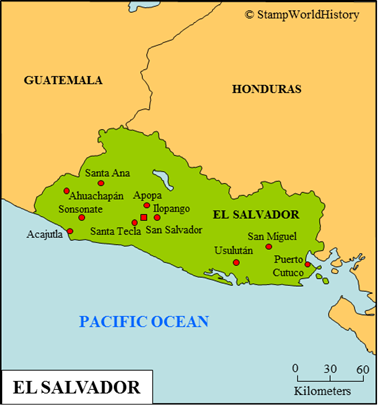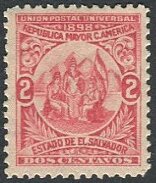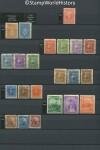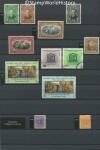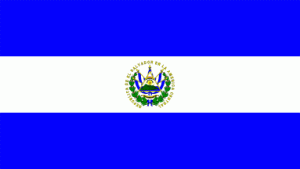
El Salvador
Quick reference
General issues: Republic 1867-1896, State of the Greater Republic of Central America 1896-1898, Republic 1898-Present
Country name on general issues: Salvador, El Salvador
Currency: 1 Peso = 100 Centavos = 8 Reales 1867-1912, 1 Colon = 100 Centavos 1912-2001, 1 Dollar = 100 Cent 2001-Present
Population: 801 000 in 1900, 6 340 000 in 2013
Political history El Salvador
Colonization and the road to independence
El Salvador is located in Central America. Before colonization, El Salvador was inhabited by a number of Amerindian peoples of which the Lenca and the Pipil were the largest group. The first Europeans to explore El Salvador were the Spanish in 1522. Colonization started in 1524. The Lenca resisted the Spanish for more than a decade and were subdued in 1537. During the colonial period, El Salvador was governed as a province of the Captaincy General of Guatemala – legally part of the Viceroyalty of New Spain but in practice self governing.
After Napoleon had conquered Spain, a wave of independence movements swept across the Spanish possessions in the Americas. El Salvador proclaimed independence in 1811, but the royalists loyal to Spain soon regained control. The war of independence in Central America was mainly fought from 1810 in the Viceroyalty of New Spain, that gained independence as the empire of Mexico in 1821. The provinces of the Captaincy General of Guatemala – including El Salvador – proclaimed independence from Spain the same year – without a shot being fired. In 1822 the provinces joined the Empire of Mexico. The empire, however, was short lived and, as the empire was dissolved in 1823, the provinces of the former Captaincy General proclaimed independence from Mexico as the United Provinces of Central America. By the constitution of 1824, the provinces would form the federal republic of Central America. The province of El Salvador was proclaimed the State of El Salvador in the same year. The federal republic of Central America would suffer from conflicts between the member states and that would soon lead to its dissolution. El Salvador became the fully independent state of El Salvador in 1841.
Independent El Salvador
El Salvador was proclaimed a republic in 1859. The official name of the country at the time was ‘Salvador’. From the 1890’s ‘El Salvador’ came to be used more and more – also in official documents. In 1915 the name was officially changed from ‘Salvador’ to ‘El Salvador’. De facto borders were established in the 1820’s. De jure the borders would be disputed until well into the 20th century. The border with Guatemala was established in 1935 and the border with Honduras in 1992.
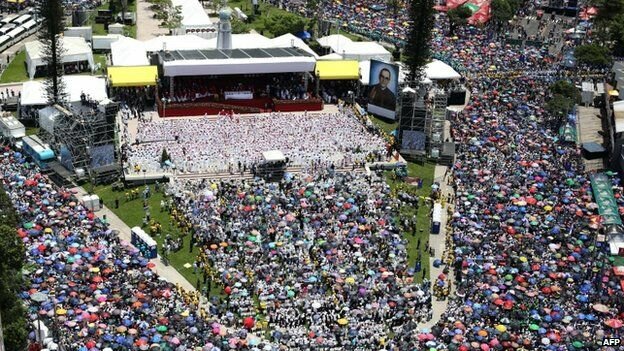
Óscar Romero, as a bishop, opposed inequality and violation of human rights in El Salvador. He was killed in 1980. Until today, Romero enjoys large popularity. Thousands attended the ceremony of his beatification in 2015.
Throughout the 19th century El Salvador was ruled by presidents – affiliated to either the Conservative or the Liberal party – coming from an oligarchy of a small number of families of large landowners. The first democratic elections were held in 1931. Democracy was short lived. Within a year the military seized power through a coup. The coup triggered a revolt among the peasants that was put down by force. In the history of El Salvador these events are called ‘La Matanza'[1]‘The Masacre’ . From the 1930’s until the 1980’s El Salvador – with one exception – was ruled by presidents coming from the military. In the 1970’s leftist guerrilla movements were formed opposing the military regime. A civil war ensued that lasted from 1979 until 1992. The government was supported by the United States to prevent a guerrilla victory. The war was characterized by frequent violations of human rights, in particular by the government death squads. One of the notable figures that died at the hands of a death squad was bishop Óscar Romero, who spoke out against the human rights violations. Romero died in 1980 and he was beatified in 2015. In 1992 a truce was signed between the government and the guerrilla movements. Since 1992, El Salvador has been ruled by democratically elected presidents.
Economy and demography
In colonial times El Salvador depended on indigo – used as a dye – as a cash crop. In the 19th century indigo was replaced by coffee. Nowadays the economy has diversified with developing sectors in industry and services. From 1992 the economy has shown slow but consistent growth. Many El Salvadorians live abroad – remittances from abroad account for 17% of the GDP. On the United Nations Human Development Index El Salvador is qualified as a middle high development country. The largest population group are the mestizos – people of mixed white and Amerindian origin. The mestizos account for 86% of the population. The indigenous Amerindian people account for 0.2% of the population.
Postal history El Salvador
The first stamps were issued in El Salvador in 1867 and show the seal of El Salvador with eleven stars for the eleven departments of the country. These, and subsequent issues, were printed by the American Bank Note Company in New York. From 1890 to 1898 the stamps of El Salvador were printed by the Hamilton Bank Note Company, also in New York, under the Nicholas Seebeck contracts. Seebeck – a director of Hamilton Co – signed a contract with El Salvador – as with Ecuador, Honduras and Nicaragua – that implied he would print stamps free of charge, valid for only one year. Any unsold stamps were to be returned to Seebeck for sale to collectors. Seebeck also had the right to reprint stamps. The Seebeck issues are most often found mint or cancelled to order. Stamps from 1867 are inscribed ‘Salvador’ and from 1896 ‘El Salvador’. In 1897 and 1898, when El Salvador is a state of the Greater Republic of Central America[2]A short lived federation of El Salvador, Honduras and Nicaragua, lasting from 1896 to 1898. , stamps are issued inscribed ‘Republica Mayor de Centro America, Estado de El Salvador’. El Salvador has, throughout its stamp issuing history, issued stamps with mainly themes of national interest. In 2001 the dollar became the main currency, although the colon remained in use. Stamps since 2001 are issued with denominations in both the dollar and the colon.
Album pages
← Previous page: EcuadorNext page: French Guiana →

